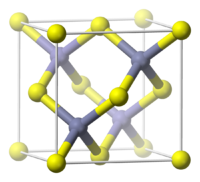
Photo from wikipedia
Abstract The composites are still worth researching, because the catalytic performance greatly varies depending on the ways when two or more particles are grafted. In this study, we report a… Click to show full abstract
Abstract The composites are still worth researching, because the catalytic performance greatly varies depending on the ways when two or more particles are grafted. In this study, we report a n-CdO/p-CdS bulk heterojunction (BHJ) nanostructures with abundant sulfur vacancy defects to improve the photoexcited charge separation during the photocatalytic reactions. The n-CdO/p-CdS nanostructured photocatalyst exhibits extended visible light absorption, reduced electron-hole recombination rate and improved photoexcited charge carriers generation, transfer and separation capability. Moreover, electronic band differences between the CdS and CdO bulk junctions creates the sulfur vacancies via CdSO3. The hydrogen production amount of the 1CdO/2CdS catalyst (1.2 μmol∙g−1) shows a remarkable performance that is 10 times higher than that of the CdO (0.02 μmol∙g−1) and CdS (0.07 μmol∙g−1) single particle catalysts. The improved photocatalytic activity can be ascribed to the intimate interfacial contact between CdS and CdO nanostructures, sulfur vacancies and efficient charge carrier separation.
Journal Title: Journal of Industrial and Engineering Chemistry
Year Published: 2020
Link to full text (if available)
Share on Social Media: Sign Up to like & get
recommendations!